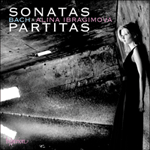The third and last of the Sonatas (BWV1005) is in the key of C major and begins with an elegiacally expressive Adagio whose writing embraces one-part to four-part texture. It leads to an immense, multiple-layered Fuga, 354 bars in length, whose single subject derives from the Pentecostal antiphon ‘Veni Sancte Spiritus’, from which the chorale melody ‘Komm, heiliger Geist, Herre Gott’ also derives. The scale of the movement, its contrapuntal density, the sustained ingenuity of the writing and its intimidating technical requirements, make it a daunting challenge to the performer. As such it may be regarded as a companion piece to the D minor Ciaccona. The lyrical and serene melody of the third movement Largo, in F major, provides both expressive contrast and necessary relief from the imposing, concentrated and technically challenging content of the Fuga which preceded it. The C major Sonata concludes with a spirited and brilliantly coloured Allegro assai in which Bach, once more, leads the performer and his instrument towards the limits of possibility.
from notes by Nicholas Anderson © 2009
La troisième et dernière sonate (BWV1005) en ut majeur commence par un Adagio à l’expression élégiaque dont l’écriture embrasse une texture qui oscille entre une et quatre parties. Il mène à une immense Fuga aux multiples voix, de trois cent cinquante-quatre mesures. Son seul et unique sujet est dérivé de l’antienne de la Pentecôte «Veni Sancte Spiritus», dont provient également la mélodie du choral «Komm, heiliger Geist, Herre Gott». L’échelle du mouvement, sa densité contrapuntique, l’ingéniosité soutenue de l’écriture et son niveau technique intimidant constituent un terrible défi pour l’instrumentiste. En tant que telle, elle peut être considérée comme le pendant de la Ciaccona en ré mineur. La mélodie lyrique et sereine du troisième mouvement, un Largo en fa majeur, apporte à la fois un contraste expressif et un soulagement nécessaire au contenu imposant, concentré et difficile sur le plan technique de la Fuga qui le précède. La Sonate en ut majeur s’achève sur un Allegro assai plein d’entrain et brillamment coloré dans lequel Bach mène une fois encore l’interprète et son instrument vers les limites du possible.
extrait des notes rédigées par Nicholas Anderson © 2009
Français: Marie-Stella Pâris
Die dritte und letzte Sonate (BWV 1005) steht in C-Dur und beginnt mit einem elegisch-expressiven Adagio, in dem die volle Bandbreite von der Einstimmigkeit bis zur Vierstimmigkeit vertreten ist. Es führt zu einer riesigen, vielschichtigen Fuga von 354 Takten hin, deren einziges Thema aus der Pfingst-Antiphon „Veni Sancte Spiritus“ stammt, von der auch die Choralmelodie „Komm, heiliger Geist, Herre Gott“ abgeleitet ist. Die Ausmaße des Satzes, die kontrapunktische Dichte, die geniale Kompositionsweise und die enormen technischen Anforderungen machen das Stück zu einer beängstigenden Herausforderung für den Interpreten. In dieser Hinsicht kann es als Pendant zu der Ciaccona in d-Moll betrachtet werden. Die lyrische und heitere Melodie des dritten Satzes in F-Dur, Largo, bietet sowohl expressiven Kontrast als auch notwendige Entspannung nach dem imposanten, konzentrierten und technisch anspruchsvollen Inhalt der vorangehenden Fuga. Die C-Dur Sonate schließt mit einem beherzten und brillant schattierten Allegro assai, in dem Bach den Interpreten und sein Instrument einmal mehr an die Grenzen des Möglichen führt.
aus dem Begleittext von Nicholas Anderson © 2009
Deutsch: Viola Scheffel


 Bach: Sonatas and Partitas for solo violin
Bach: Sonatas and Partitas for solo violin
